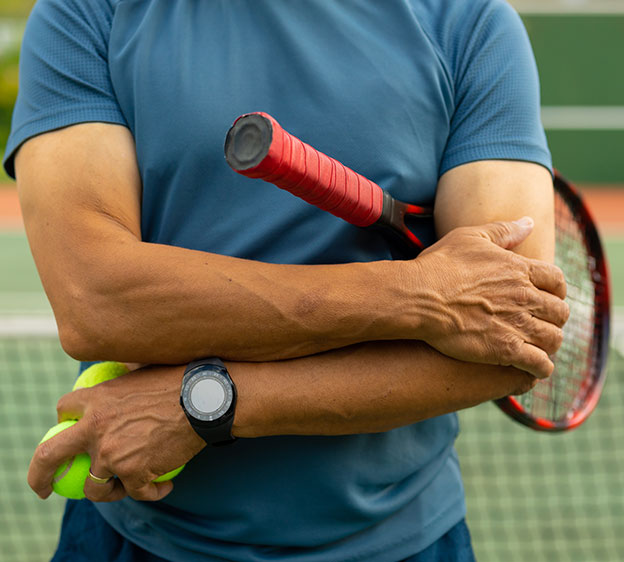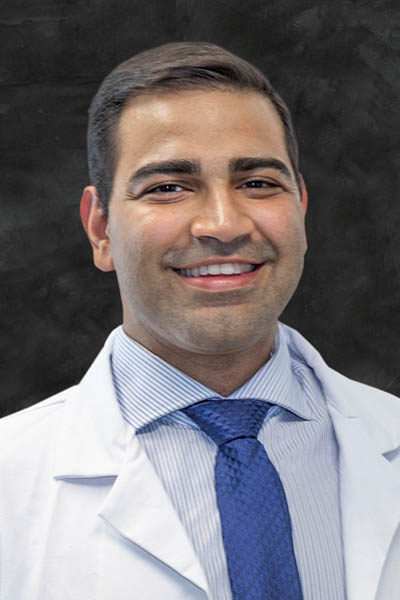Game, Set, Heal: Finding Tennis Elbow Treatment That’s Right for You
July 26, 2024Categories: Elbow Pain

Just like knee pain and back pain, elbow pain is common as active people age. A common cause of elbow pain in adults over 40 is a condition called tennis elbow, a type of tendinitis caused by overuse. Fortunately, this condition is treatable, and up to 95% of patients with tennis elbow will not need surgery. It’s important to find the right tennis elbow treatment for your body and lifestyle, as many different situations can cause the condition.
“Surprisingly, only around 10% of patients who develop tennis elbow are actual tennis players,” says Dr. Vandit Sardana, a board-certified, fellowship-trained orthopedic surgeon at Beaufort Memorial. “People who perform repetitive manual labor, such as construction workers or restaurant cooks, are more likely to get tennis elbow.”
Read More: Elbow Bursitis 101: Decoding Your Elbow Pain
What Is Tennis Elbow?
Tennis elbow, also called lateral epicondylitis, affects around 1% to 3% of the population. It is usually caused by repetitive strain of the muscles and tendons that attach to the outside of the elbow joint. Over time and with prolonged overuse, your forearm muscles can develop tiny tears that cause elbow pain. Poor technique or improper equipment when playing racquet sports may cause this damage, but so can overuse and repetitive twisting. It is more common in your dominant arm but can affect either elbow.
Could You Have Tennis Elbow?
Only a medical provider can diagnose you with tennis elbow. But if you have ongoing elbow pain, you should know that symptoms of tennis elbow include:
- Burning sensation on the outer part of your elbow
- Pain on the outer part of your elbow
- Weak grip
“The pain may be so bad it keeps you up at night,” Dr. Sardana says. “The pain may also radiate down your arm when you use your forearm. Simple tasks such as opening a jar, shaking hands, or using a wrench may make your pain worse.”
If you have pain on the inside of the elbow, not the outside, you may have a condition called golfer’s elbow. However, treatment for both conditions is similar.
Read More: A Primer on Preventing Bone and Joint Problems
Who’s at Risk?
People between 40 and 60 are the most likely to develop tennis elbow, and people who smoke or are obese have a higher risk. However, anyone who uses their forearms for repetitive work or recreational activities is at risk of the condition, including:
- Athletes
- Cooks and butchers
- Manual laborers, such as carpenters, painters and plumbers
- Musicians, such as drummers, piano players and violinists
- People who work at a cash register or computer
- Seamstresses or tailors
Elbow pain affects about half of tennis players, where an estimated three quarters of those affected likely have true tennis elbow.
“You are more likely to feel pain from the condition when hitting backhand,” Dr. Sardana says. “People who play other racket sports, such as squash or pickleball, are also at risk, as are athletes such as rowers or weightlifters.”
Read More: Common Elbow Injuries: How to Reduce Your Risk
Tennis Elbow Treatment Without Surgery
Most people with tennis elbow will get better with rest and time. But if your job is causing your elbow pain, it may not be feasible to rest your arm for several months. Luckily, many types of nonsurgical treatments can relieve pain and help you learn to prevent overuse in the future. Common treatment options may include:
- Bracing, which can help support and relieve your muscle strain
- Non-steroidal anti-inflammatory drugs (NSAIDs), such as ibuprofen and naproxen, that may reduce pain
- Occupation and physical therapy, where you will learn strengthening exercises to practice at home multiple times a day
- Steroid injections, which can relieve pain and inflammation in your elbow
There are also several types of less conventional treatment methods that your doctor may recommend, including:
- Acupuncture, a traditional Chinese medicine technique that uses tiny needles to manipulate pressure points in the body
- Botox injections, an alternative to steroid injections that may have a similar pain-reducing effect
- Extracorporeal shock wave therapy, a process that sends sound waves through the elbow to speed up the healing process
- Platelet-rich plasma (PRP), a biological treatment that uses platelets from your own blood to speed the healing process. Platelets are filtered from your blood after a simple blood drawn and then reinjected into the elbow.
Many patients have found relief using these methods, and they are all safe, but there is a lack of consensus in the research as to how effective they are.
“If you are an athlete with tennis elbow, part of your treatment may involve adjusting your equipment or working with a professional trainer to improve your form,” Dr. Sardana says. “People with work-related injuries may also need to adjust how they do their tasks, which occupational therapy can assist with.”
Read More: Find the Best Shoes for Knee Pain: A Runner’s Guide
When Surgery Is Needed
If nonsurgical methods to treat tennis elbow have been unsuccessful after 6 to 12 months, your provider may recommend surgery. In most cases, your surgeon will remove the damaged part of the tendon and then reattach the healthy part back to your bone. This is usually an outpatient procedure, which means you can go home the same day. Depending on the damage in your elbow shown by magnetic resonance imaging (MRI), you may need:
- Arthroscopic surgery, a minimally invasive option that uses a tiny camera to help your surgeon visualize what needs repair.
- Open surgery, a procedure that uses a larger incision to allow your surgeon to repair the tendon.
“Surgical procedures are successful in up to 90% of patients, but there is a risk of infection, nerve damage or other complications,” Dr. Sardana says. “You may lose strength after surgery, so it is important to do all the exercises your physical therapist recommends as you heal.”
If elbow pain is keeping you off the court or out of work, it’s time to talk to a Beaufort Memorial orthopedic specialist. Our providers use advanced diagnostic imaging and the latest treatment modalities to help ensure you can get back to your career or your matches as quickly as possible.
If you’re experiencing elbow pain, Beaufort Memorial can help. Find an orthopedic specialist.

